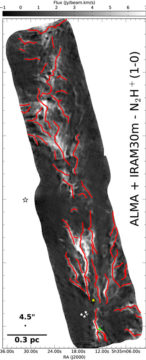New ALMA observations reveal a fiber-like structures within a longer, well-studied filament in the Orion Nebula. These fibers contain the seeds of future stars.
Stars are spherical, and so are the gaseous seeds out of which they collapse. Yet new observations are showing that the massive clouds that are home to those seeds aren’t spherical at all — within those clouds, gas collapses first into dense fibers that braid into long, thin filaments.*

ESO / H. Drass / ALMA (ESO / NAOJ / NRAO) / A. Hacar
American astronomer Edward Barnard first noticed these filaments in star-forming regions in his 1919 catalog “On the dark markings of the sky.” He called them “vacant lanes” (because they appear dark and empty when seen in visible light) and wondered about their connection to nearby infant stars. But it took decades for astronomers to resolve the details and fully realize the connection.
Back in 2015 Alvaro Hacar (now at Leiden University, The Netherlands) and colleagues found that a 30-light-year-long filament was actually more like a rope made of smaller bundles of “fibers.” These denser regions of gas are each typically 1½ light-years long. The seeds of future stars — compact areas that will eventually collapse into stars but haven’t yet — can be seen as knots in these braids.

Hacar et al. 2018 / Astronomy & Astrophysics
Hacar thought fibers might act like Legos — the fundamental building blocks of star formation. But that conclusion came from observations of a relatively sparse region in Taurus that would only ever form low-mass stars. It wasn’t clear whether the bundle-of-fibers scenario seen in low-mass star-forming regions would apply to the denser environments where high-mass stars (stars with more than eight times the Sun’s mass) form.
Some thought that denser regions would have more massive fibers. If so, they’d be less stable and would fragment more easily. Or, such regions might simply have more bundles, rather than more massive ones. Hacar predicted the latter scenario, which would fit in line with the Lego scenario.
High-mass star-forming regions are rare and far away, making them difficult to observe. So to investigate their idea in denser regions, Hacar and colleagues turned to the sharp-eyed Atacama Large Millimeter/submillimeter Array.
ALMA zoomed in on the 20-light-year-long Integral-Shaped Filament that crosses massive star-forming regions in the Orion Nebula. The observations trace emission from structures as small as 2,000 astronomical units across. (That’s quite the feat for something that’s 1,350 light-years away; it’s equivalent to resolving a 5-mile-wide crater on the Moon.)
The team found a network of 55 fibers that are part of the larger filament, in some areas forming designs reminiscent of airport hubs. When combined with observations of other star-forming regions, the result fits into a pattern of more fibers in more massive regions. The only difference is that Orion’s fibers are on average three times shorter than the ones the researchers spotted in Taurus, typically only ½ light-year long.
It appears that, no matter what star-forming region you look at, there are filaments made of smaller fibers that hold the seeds of future stars.
Find more beautiful images and data visualizations from the Orion-4D project here.
* Seem strange? Cosmological simulations say our universe formed the same way. Solely under the influence of gravity, gas will collapse first into web-like filaments, and only then into the cores out of which galaxies (or stars) form.
 1
1









Comments
Lindsay
March 23, 2018 at 8:37 pm
...but why fibers/filaments? Any theories? Dark matter involved?
You must be logged in to post a comment.
You must be logged in to post a comment.